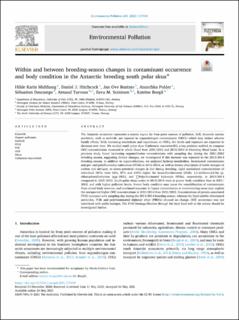| dc.description.abstract | The Antarctic ecosystem represents a remote region far from point sources of pollution. Still, Antarctic marine predators, such as seabirds, are exposed to organohalogen contaminants (OHCs) which may induce adverse health effects. With increasing restrictions and regulations on OHCs, the levels and exposure are expected to decrease over time. We studied south polar skua (Catharacta maccormiciki), a top predator seabird, to compare OHC concentrations measured in whole blood from 2001/2002 and 2013/2014 in Dronning Maud Land. As a previous study found increasing organochlorine concentrations with sampling day during the 2001/2002 breeding season, suggesting dietary changes, we investigated if this increase was repeated in the 2013/2014 breeding season. In addition to organochlorines, we analyzed hydroxy-metabolites, brominated contaminants and per- and polyfluoroalkyl substances (PFAS) in 2013/2014, as well as dietary descriptors of stable isotopes of carbon and nitrogen, to assess potential changes in diet during breeding. Lipid normalized concentrations of individual OHCs were 63%, 87% and 105% higher for hexachlorobenzene (HCB), 1,1-dichloro-2,2-bis (p- chlorophenyl)ethylene (p,p’-DDE), and ∑Polychlorinated biphenyls (PCBs), respectively, in 2013/2014 compared to 2001/2002. South polar skuas males in 2013/2014 were in poorer body condition than in 2001/ 2002, and with higher pollutant levels. Poorer body condition may cause the remobilization of contaminants from stored body reserves, and continued exposure to legacy contaminants at overwintering areas may explain the unexpected higher OHC concentrations in 2013/2014 than 2001/2002. Concentrations of protein-associated PFAS increased with sampling day during the 2013/2014 breeding season, whereas the lipid-soluble chlorinated pesticides, PCBs and polybrominated diphenyl ether (PBDEs) showed no change. OHC occurrence was not correlated with stable isotopes. The PFAS biomagnification through the local food web at the colony should be investigated further. Organic pollutants Seabirds PFAS PCB HCB Mirex Catharacta maccormicki | |
